Making up the difference
In a discipline where podiums are regularly separated by a couple of seconds, making up the...
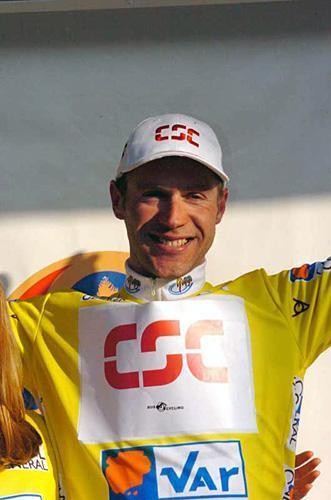
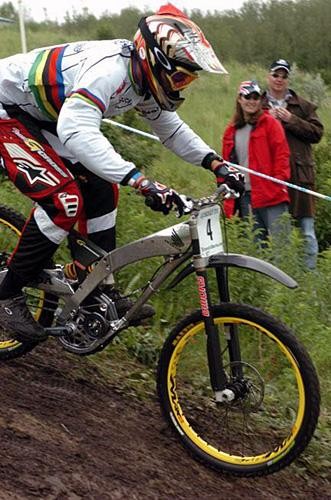
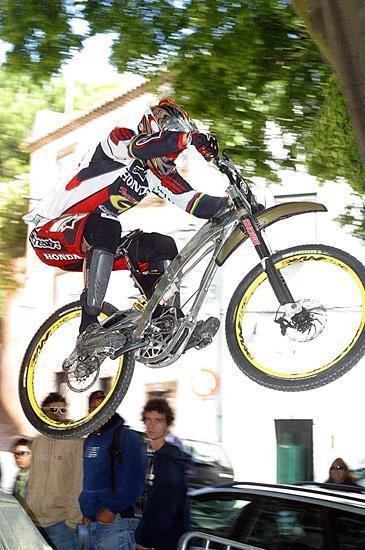
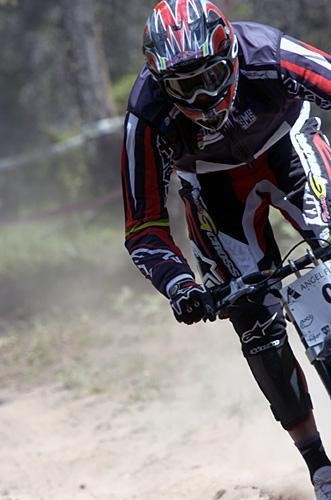
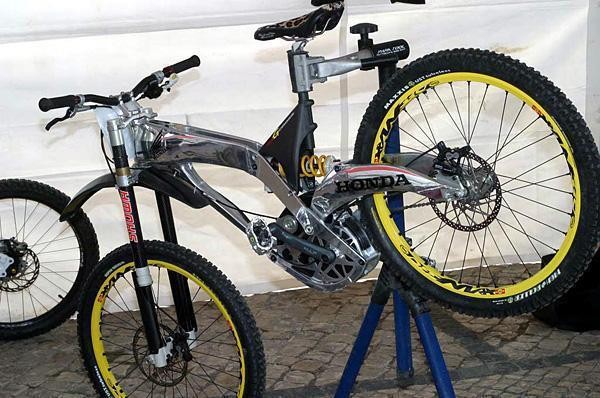
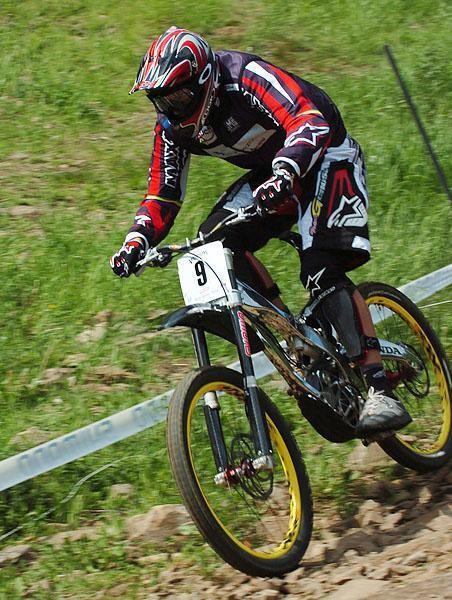
An interview with Greg Minnaar, July 28, 2005
In a discipline where podiums are regularly separated by a couple of seconds, making up the difference on your opponents is the secret to success. Newly-crowned World Cup downhill champ Greg Minnaar knows how to do this, and tells Cyclingnews' Steve Medcroft all about it.
When South African Greg Minnaar (Team G-Cross Honda) straddled his custom-made Honda RN01 in the downhill start house at the Angel Fire, New Mexico World Cup round, he knew he was in a position to seal the World Cup points series. All he needed was a solid run and a reasonable placing.
Australian Jared Graves, who had beaten Minnaar in the semi by 2.29 seconds, had set the fastest time thus far. Minnaar started off fast, picking his lines and pedaling for speed where he could. As he passed under the intermediate timing mark, he was 0.49 seconds behind and said later that he felt he needed to make up time.
He took chances through the remainder of the run and only after turning to look at the timing board at the bottom of the course did he know that he had overtaken Graves by two-tenths of a second and finally locked up the World Cup series.
We caught up with Minnaar a week later, as he was preparing for downhill competition in Sandpointe, Idaho (Schweitzer Mountain Resort NORBA, July 17,2005 - a race in which Minnaar came second to countryman Andrew Neethling).
Cyclingnews: You won Angel Fire by 0.22 seconds. Your split at the top of the course put you behind Jared Graves. What did you do to make the difference?
Get The Leadout Newsletter
The latest race content, interviews, features, reviews and expert buying guides, direct to your inbox!
Greg Minnaar: At Angel Fire, I felt that I hadn't ridden well enough to be the fastest in the top section. Graves was really fast in training and in the semi finals and I really wanted the World Cup title over and done with so I had to expand myself. I pedaled a lot and took more risks down the bottom than maybe I should have. It was good to win.
CN: How do you get fit enough to turn on the gas when you need it in an event where you're going all out, all the time?
GM: We do a lot of training; especially before the season starts. We do endurance work. We do a lot of sprint intervals because that's pretty much what downhill is - ten seconds of sprinting, then a break, then another sprint - all down the course. We make sure we get those intervals worked out pretty good before the season starts.
CN: You work out on road bike, mountain bike, bmx?
GM: I prefer mountain bike. I have a hard tail that I train on quite a bit. My coach sets all the programmes. For me, I just follow what he says.
CN: This is your second World Cup title.
GM: 2001 was the first. In 2002 I had a really bad season. Nothing went my way and I ended up with a broken collarbone. In 2003, I had a pretty decent season, but no great sparks. Then, at the end of the year, I came on really strong for World Championships. Last year we focused on NORBAs, which conflicted with World Cups, so I didn't go after the World Cup series. This year, we focused on World Cups and I'm glad we're doing it - I think World Cup racing is where it's at.
CN: You're still racing NORBA events though?
GM: We're just going to do two this year. Again, the NORBA schedule conflicts with the World Cup schedule, which is ridiculous. I can't understand how come the different series' can't all flow and be hassle free and easy to travel. They make it so difficult.
CN: Do your sponsors prefer the exposure of NORBA or international racing?
GM: Honda wanted us to race World Cups this year for sure.
CN: Speaking of Honda, tell me about the famous $70,000 bike.
GM: Honda wanted to have the best bike out there and I think they've got it. It's pretty special - not having a regular chain drive but the gearbox. The internal gears make the handling of the bike a lot different. The majority of the weight is in the center of the bike which is really good for cornering. I think Honda were the first to keep all the gearing centralised (versus rear hub-based gearing systems). I still don't see any other brands mixing it up with us for a different transmission setup.
CN: Did you feel the difference the first time you rode this bike?
GM: The handling is different but you don't have to change the way you ride though. You just feel comfortable way quicker than on a regular bike.
CN: The suspension is custom as well?
GM: Right. We don't really have traditional mountain bike suspension; we have a motorcycle company, Showa, making ours. One of their technicians travels with us to set it up for races. They put an awesome amount of effort into it.
CN: But the suspension is not offered for sale on bicycles. So why do they do it?
GM: They do it more for research and development. I think downhill is really good for a suspension company to improve their product because you're contradicting the way suspension works - you want it as soft as possible for the little rocks, the little bumps, but you do massive drops so you want it as hard as possible sometimes. They try different setups and materials and they tell us they get a lot of benefit from the work.
CN: How did you first get into downhill?
GM: I raced motocross for about ten years (from age four to fourteen), then my parents bought a bicycle shop (Two Wheel & Cycles). When they got that, there was no time for me to race motocross; I was always in the shop. So I rode bikes instead. I raced cross country, but I was more suited to downhill - I was used to the higher speed and the bigger jumps. Downhill was where I had more fun too. I didn't like going uphill that much; didn't see the fun in it. You got to the top and you couldn't talk to your mates. You do a downhill run and you weren't pushing that hard. You could talk straight afterwards.
CN: Did motocross prepare you to be a good downhill racer?
GM: I think so. A lot of (downhill racers) started with motocross. It's a good way to learn the handling you need for downhill. You just get used to higher speeds. It helps your upper body strength.
CN: For someone who's never done a downhill run, what's it like?
GM: What drives us when we race are those moments when you're going so fast around corners that your tires are barely gripping and when you finish, your hands shake from the adrenalin. It's great fun. And I think most average riders could do it - ride down the average downhill run. The skill comes in when you want to ride them faster.
CN: Is getting faster just about picking the faster line?
GM: Lines are important in racing - you look for the shortest line, the quickest line in a race - but some people might feel comfortable going around a rock section and some people might feel comfortable going over it, so going over might be quicker in that case; it all comes down to your riding skill and riding ability. You have to be good at all things in downhill; it's very competitive. And what it takes to be good might vary course to course.
CN: When you know you're having a good run, do you fall into a flow? Is it effortless?
GM: It's sure isn't effortless. As soon as it becomes effortless, you're not pushing fast enough. We do have to pedal the bike to get up to speed. You've got to brake. You have to be able to move the bike around.
CN: Is success in downhill due to fitness, genetics, or mentality?
GM: That's a hard one to answer. I would say it's a bit of everything. For sure, you have to be fit to race; there's no way you can race these days without putting in the training time. But the mental aspect plays a big part too. Psychologically, you have to be prepared. You only have five minutes to do your run and you have to try and nail every single line, everything you've practiced - and you have one chance to do it in the final. There is a lot going on in downhill and I think you have to be an all-rounder to do well at it.
CN: What's different between the guys who consistently podium and guys who consistently place in the middle of the pack?
GM: A lot of it could be physical. I think that when you pedal a bike out of a corner and you're .01 faster than another guy on that one corner, all those corners add up to a couple of seconds at the bottom. If you're not physically prepared, you're going to lose time every time you have to pedal.
CN: You've had a chance to race a lot of different courses. What are some of the best downhill runs in the world?
GM: I think definitely Brazil (Balneário Camboriú - Santa Catarina Brazil) a few weeks ago was a good one. The downhill finished a hundred metres from the beach. That was just awesome; you could just strip down after your run and jump right into the ocean. I used to really love riding in Mammoth (California) too. Mammoth was awesome.
CN: You've been second once, third once, and were World Champion in 2003 - what do you feel are your chances in this year's World Championships?
GM: I guess I've got as good of a chance as anyone else. It's the same for everyone at every World Championships - you try and be fast on that one day. I'm going home for a couple of weeks break and to start preparing for World Championships. We'll see what happens when we get there.
CN: Are you doing the last World Cup (Fort William, Scotland, Sept 10, 2005), even though you've now won the series?
GM: Yeah. That's my closest race to home. I've got a lot of friends in England; I used to race there. So they'll come up. There are a lot of South Africans that live there now too and I normally get a lot of support from them.